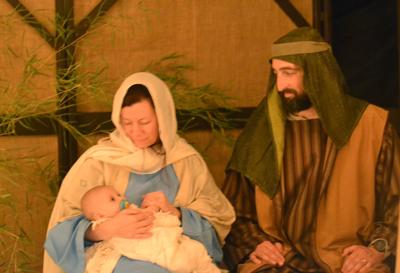This is the 25th anniversary of Facets of Faith. To observe that milestone, I have been rerunning columns from the past. This one ran Dec. 3, 2005.
Live performances at Christmas have been popular with churches for many years.
How many years?
Possibly since Christmas Eve 1223.
Tradition holds that St. Francis of Assisi produced the first live Nativity scene that year in Greccio, Italy, a village outside of Assisi.
St. Francis sought a way to show himself and the people of the area the wonder and joy of Jesus’ birth. “I want to observe the memory of the child who was born at Bethlehem. I want to see in some way before my bodily eyes the discomforts of his baby needs, how he was laid in a manger, and how with the ox and ass standing by, he was there on the hay,” Francis said.
To avoid accusations of taking the manner too lightly, Francis sought and received permission from the pope to celebrate Christmas in a different manner.
St. Francis returned to Assisi and sent a message to his friend Giovanni Velita, a nobleman from Greccio, requesting help in preparations.
“And I should like to commemorate his birth at Bethlehem in a way to bring me as perfectly as possible the sufferings and discomforts he endured from infancy for our salvation,” Francis said.
The men prepared a cave, creating a stable scene to greet villagers on Christmas Eve. Live animals were used. Some of Francis’ followers sang praises to Christ. Then Francis said Mass on the rock above the cave.
St. Bonaventure wrote in a biography of Francis, “Many brothers and good people came at Francis’ bidding, and during the night the weather was also beautiful. Many lights were kindled, songs and hymns were sung with great solemnity so that the whole wood echoed with the sound.”
This event may not have been the first recreation of the Bethlehem story, but it sparked interest in representing Christ’s birth and established the custom, which spread from Italy to Austria, Germany, Spain, Poland and eventually the New World.
The live Nativities led to the doll-type creches commonly seen today. These gained in popularity in the 16th century, starting in churches and moving into homes.
Nativity in art Depictions of the Nativity are found early in art. One of the oldest-known depictions is a wall painting on the funeral chamber of a Christian family who lived around 380. This art was discovered in 1877 in the catacombs of St. Sebastian in Rome.
In a word
In English, we often speak of the “creche” or “manger” scene, but both words originally meant feeding trough. Manger came to English through Latin, and creche came through French.
Other terms for the scene:
Presepio: Italian.
Krippe: German.
Nacimiento: Spanish.
Sources: “The Lessons of St. Francis,” John Michael Talbot; The Perennial Dictionary of World Religions, Keith Crim, editor; The HarperCollins Dictionary of Religion, Jonathan Z. Smith, editor; World Book; www.newadvent.org/cathen/06221a.htm; www.catholic.org; christianhistoryinstitute.org/magazine/article/francis-of-assisi-did-you-know; www.catholiceducation.org/en/culture/catholic-contributions/st-francis-and-the-christmas-creche.html

